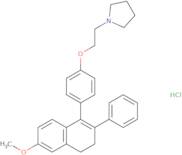Nafoxidine Hydrochloride
CAS: 1847-63-8
Ref. 3D-BAA84763
| 5mg | Discontinued | ||
| 10mg | Discontinued | ||
| 25mg | Discontinued | ||
| 50mg | Discontinued | ||
| 100mg | Discontinued |
Product Information
- 1-(2-(p-(3,4-Dihydro-6-methoxy-2-phenyl-1-naphthyl)phenoxy)ethyl)pyrrolidine hydrochloride
- 1-(2-(p-(6-Methoxy-2-phenyl-3,4-dihydro-1-naphthyl)phenoxy)ethyl)pyrrolidine hydrochloride
- 1-{2-[4-(6-Methoxy-2-Phenyl-3,4-Dihydronaphthalen-1-Yl)Phenoxy]Ethyl}Pyrrolidine
- 11100A
- Ccris 3620
- NSC 70735
- Nafoxidine HCl
- Nafoxidine hydrochloride [USAN:INN]
- Pyrrolidine 1-(2-(4-(3,4-dihydro-6-methoxy-2-phenyl-1-naphthalenyl)phenoxy)ethyl)-, hydrochloride
- Pyrrolidine, 1-(2-(p-(3,4-dihydro-6-methoxy-2-phenyl-1-naphthyl)phenoxy)ethyl)-, hydrochloride
- See more synonyms
- Pyrrolidine, 1-[2-[4-(3,4-dihydro-6-methoxy-2-phenyl-1-naphthalenyl)phenoxy]ethyl]-, hydrochloride (1:1)
- U 11100
- U 11100A
- Unii-Su8Wbd61G1
Nafoxidine hydrochloride is a structural analog of tamoxifen. It has been shown to be effective against cancer cells that contain nuclear DNA. Nafoxidine hydrochloride inhibits estrogen and antiestrogen receptor activity, which may provide an alternative treatment for breast cancer. The drug is also used in the treatment of bowel diseases, such as ulcerative colitis and Crohn's disease. Nafoxidine hydrochloride has minimal toxicity and can be administered orally or intravenously. In addition, it has been shown to have anti-cancer effects in experimental models involving mitochondrial membrane potential and BCR-ABL kinase.





